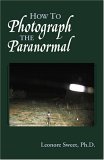 How
to Photograph the Paranormal
How
to Photograph the Paranormal  How
to Photograph the Paranormal
by Leonore Sweet,
Ph.D.
199 pages -
Illustrated (color/B&W)
2005 / Hampton Roads
Publishing Co., Inc. - $16.95 (new)
How
to Photograph the Paranormal
by Leonore Sweet,
Ph.D.
199 pages -
Illustrated (color/B&W)
2005 / Hampton Roads
Publishing Co., Inc. - $16.95 (new)
This book is among one of the first works I purchased when it became apparent that my ghost hunting interests were becoming more than just a hobby. As a "point-and-click" sort of photographer my increasingly frequent trips to reputedly haunted local spots failed to produce the hair-raising evidence on film I longed for, so rather than signing up for an expensive photography class, I opted for this "How to ..." volume. The wealth of bibliographic resources and topical on-line internet references included are alone well worth the invested price.
This is not a technical manual, filled with discussions of correct shutter speeds and aperture opening settings. The nuts and bolts of camera operation is a subject barely touched upon. Neither does the book promote a preference for one type of camera equipment over another, although the debate of digital pixels versus processed film is briefly addressed. Instead, the bulk of information between the covers consists of advice and common sense tips which serve to increase a ghost hunter's chances of bagging his illusive quarry. Additionally, a thorough exploration of the varied forms that paranormal energies may present if successfully captured through the lens, can save an attentive novice or even an intermediate picture taker wasted time, PC storage space, and embarrassing declarations regarding proof of afterlife activity.
The controversial art of paranormal photography is burdened by the inherent and near improbable [skeptics prefer 'impossible'] task of establishing unequivocal documentary proof, therefore I salute Dr. Sweet for the pains she exercised in distinguishing the subtle variances of appearance in her non-physical subject matter. Accompanied by both color and black and white photos, vortexes, ectoplasm, shadow people, apparitions, angels, UFOs, inter-dimensional beings, crop circles, ghosts, spirits, souls, unknown quasi-biologic forms (rods & sky-fish), five categories of visible light anomalies and the ubiquitous, much disparaged, humble orb are among the many topics studied with a surprising depth. The research underlying the work is comprehensive, educationally illuminating, and unbiased in its presentation of history, hoaxes and informational theories, pro and con. A refreshing aspect of Sweet's writing style is that she does not fall prey to the heavy-handed pedantry common among many authors saddled with higher degrees. Rather, a light-hearted, self-effacing thread of humor throughout promotes the feeling of being engaged in an easy chat about hobbies over a cup of coffee with a friend. Another intriguing tendency is her ability to admit 'I have no idea what this is," when she might have as easily declared the questionable shot as anything from a fly's eye to apocalyptic horsemen.
Her discourse is not limited to the "physicality" of captured phenomena, but also broaches the metaphysical and spiritual implications lying at its heart. Of her readers she neither requires their belief in nor seeks to convert any into disciples of the esoterica of which she is an adherent. As related in the introduction, this work is a result of her own personal search for a meaningful understanding of life's mysteries, hence the poignancy of a photograph taken of a family member mere moments after she succumbed to cancer. Instead of a macabre depiction of a hideous disease, the single orb hovering above the bedside mourners shines forth with the comforting and tantalizing potential of an existence beyond this one. Dust?...perhaps, but in the final tally, isn't that the end we all eventually come to?
4 **** of 5***** - LadyJEM - 1/9/11